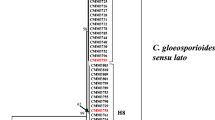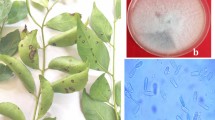Abstract
Colletotrichum gloeosporioides sensu lato has been associated with anthracnose in diverse commercial crops. It is now established that C. gloeosporioides sensu lato comprises 33 phylogenetic species and C. gloeosporioides sensu stricto is not a common pathogen of tropical fruits. In this study, we investigated the phylogenetic relationships of 85 Colletotrichum isolates associated with select tropical fruits and flowering plants from India. In the ApMat marker analysis, the 85 isolates clustered with 7 known Colletotrichum species (C. aotearoa, C. dianesei, C. endomangiferae, C. musae, C. siamense, C. theobromicola, Glomerella cingulata f. sp. camelliae) and six novel lineages. One of the novel lineages is described and illustrated in this paper as Colletotrichum communis sp. nov., while new-host pathogen associations for C. aotearoa, C. endomangiferae, C. dianesei and C. theobromicola are reported from India. Out of the 85 isolates analysed in this paper, 73 isolates clustered within the C. siamense species complex, indicating that C. siamense species complex, not C. gloeosporioides sensu stricto, is common on tropical fruits. In comparison with act, cal, gapdh, ITS and tub2 gene markers, we recommend the use of the ApMat marker for accurate identification of cryptic species within the C. siamense species complex. We believe that the ApMat marker, in combination with one or two similar ‘phylogenetically superior’ gene markers, is a better candidate for species-level classification of fungi that were traditionally identified as ‘Colletotrichum gloeosporioides’.





Similar content being viewed by others
References
Abd-Elsalam KA, Roshdy S, Amin OE, Rabani M (2010) First morphogenetic identification of the fungal pathogen Colletotrichum musae (Phyllachoraceae) from imported bananas in Saudi Arabia. Genet Mol Res 9:2335–2342
Awa OC, Samuel O, Oworu OO, Sosanya O (2012) First report of fruit anthracnose in mango caused by Colletotrichum gloeosporioides in Southwestern Nigeria. Int J Sci Tech Res 1:30–34
Cai L, Hyde KD, Taylor PWJ, Weir BS, Waller J, Abang MM, Zhang JZ, Yang YL, Phoulivong S, Liu ZY, Prihastuti H, Shivas RG, McKenzie EHC, Johnston PR (2009) A polyphasic approach for studying Colletotrichum. Fungal Divers 39:183–204
Chadha KL (2009) Handbook of horticulture. Directorate of Information and Publication of Agriculture. ICAR. Pusa, Krishi Anusandhan Bhavan, pp 239–245
Cheng BP, Huang YH, Song XB, Peng AT, Ling JF, Chen X (2013) First report of Colletotrichum siamense causing leaf drop and fruit spot of Citrus reticulata Blanco cv. Shiyue Ju in China. Plant Dis 97:1508–1508
Damm U, Wouldenberg JHC, Cannon PF, Crous PW (2009) Colletotrichum species with curved conidia from herbaceous hosts. Fungal Divers 39:45–87
Damm U, Cannon PF, Woudenberg JHC, Johnston PR, Weir BS, Tan YP, Shivas RG, Crous PW (2012a) The Colletotrichum boninense species complex. Stud Mycol 73:1–36
Damm U, Cannon PF, Woudenberg JHC, Crous PW (2012b) The Colletotrichum acutatum species complex. Stud Mycol 73:37–113
Dickens JSW, Cook RTA (1989) Glomerella cingulata on Camellia. Plant Pathol 38:75–85
Doyle VP, Oudemans PV, Rehner SA, Litt A (2013) Habitat and host indicate lineage identity in Colletotrichum gloeosporioides s. l. from wild and agricultural landscapes in North America. PLoS One 8:e62394
DCGIS Annual Report (2014) Agriculture and Processed food products Export Development Authority (APEDA), Ministry of Commerce and Industry, Government of India, information accessed online on 28th August, 2014 from http://www.apeda.gov.in/apedawebsite/index.asp
Farr DF, Rossman AY (2014) Fungal databases, systematic mycology and microbiology laboratory, ARS, USDA. Retrieved October 4, 2014, from http://nt.ars-grin.gov/fungaldatabases/
Felsenstein J (1985) Confidence limits on phylogenies: an approach using the bootstrap. Evolution 39:783–791
Hibbett DS, Taylor JW (2013) Fungal systematics: is a new age of enlightenment at hand? Nat Rev Microbiol 11:129–133
James RS, Ray J, Tan YP, Shivas RG (2014) Colletotrichum siamense, C. theobromicola and C. queenslandicum from several plant species and the identification of C. asianum in the Northern Territory, Australia. Australas Plant Dis Notes 9:1–6
Kapila U (ed.) (2009) Indian economy since independence. Academic Foundation
Kishino H, Hasewaga M (1989) Evaluation of maximum likelihood estimate of the evolutionary tree topologies from DNA sequence data, and the branching order of Hominoidea. J Mol Evol 29:170–179
Li Z, Liang YM, Tian CM (2012) Characterization of the causal agent of poplar anthracnose occurring in the Beijing region. Mycotaxon 120:277–286
Lima NB, Batista MVDA, De Morais Jr MA, Barbosa MA, Michereff SJ, Hyde KD, Câmara MP (2013) Five Colletotrichum species are responsible for mango anthracnose in northeastern Brazil. Fungal Divers 61:75–88
Liu F, Damm U, Cai L, Crous PW (2013) Species of the Colletotrichum gloeosporioides complex associated with anthracnose diseases of Proteaceae. Fungal Divers 61:89–105
Manamgoda DS, Udayanga D, Cai L, Chukeatirote E, Hyde KD (2013) Endophytic Colletotrichum from tropical grasses with a new species C. endophytica. Fungal Divers 61:107–115
Mistry NC, Singh B, Gandhi CP (2014) Indian horticulture database-2013. National Horticulture Board, Ministry of Agriculture, Government of India, New Delhi
Montri P, Taylor PWJ, Mongkolporn O (2009) Pathotypes of Colletotrichum capsici, the causal agent of chili anthracnose in Thailand. Plant Dis 93:17–20
Page RDM (1996) TREEVIEW: an application of display phylogenetic trees on personal computers. Comput Appl Biosci 12:357–358
Peng LJ, Yang YL, Hyde KD, Bahkali AH, Liu Z (2012) Colletotrichum species on Citrus leaves in Guizhou and Yunnan provinces, China. Cryptogam Mycol 33:267–283
Phoulivong S, Cai L, Chen H, McKenzie EH, Abdelsalam K, Chukeatirote E, Hyde KD (2010) Colletotrichum gloeosporioides is not a common pathogen on tropical fruits. Fungal Divers 44:33–43
Prihastuti H, Cai L, Chan H, McKenzie EHC, Hyde KD (2009) Characterization of Colletotrichum species associated with coffee berries in northern Thailand. Fungal Divers 39:89–109
Rojas EI, Rehner SA, Samuels GJ (2010) Colletotrichum gloeosporioides s.l. associated with Theobroma cacao and other plants in Panama: multilocus phylogenies distinguish host-associated pathogens from asymptomatic endophytes. Mycologia 102:1318–1338
Sharma G, Kumar N, Weir BS, Hyde KD, Shenoy BD (2013) The ApMat marker can resolve Colletotrichum species: a case study with Mangifera indica. Fungal Divers 61:117–138
Silva DN, Talhinas P, Várzea V, Cai L, Paulo OS, Batista D (2012) Application of the Apn2/MAT locus to improve the systematics of the Colletotrichum gloeosporioides complex: An example from coffee (Coffea spp.) hosts. Mycologia 104:396–409
Su YY, Noireung P, Liu F, Hyde KD, Moslem MA, Bahkali AH, Abd-Elsalam KA, Cai L (2011) Epitypification of Colletotrichum musae, the causative agent of banana anthracnose. Mycoscience 52:376–382
Swofford DL (2003) PAUP*. Phylogenetic analysis using parsimony (*and other methods). Version 4. Sinauer Associates, Sunderland
Tamura K, Peterson D, Peterson N, Stecher G, Nei M, Kumar S (2011) MEGA5: molecular evolutionary genetics analysis using maximum likelihood, evolutionary distance, and maximum parsimony methods. Mol Biol Evol 28:2731–2739
Udayanga D, Manamgoda DS, Liu X, Chukeatirote E, Hyde KD (2013) What are the common anthracnose pathogens of tropical fruits? Fungal Divers 61:165–179
Vaidya G, Lohman DJ, Meier R (2011) SequenceMatrix: concatenation software for the fast assembly of multi-gene datasets with character set and codon information. Cladistics 27:171–180
Vieira WA, Michereff SJ, de Morais Jr MA, Hyde KD, Câmara MP (2014) Endophytic species of Colletotrichum associated with mango in northeastern Brazil. Fungal Divers 67:181–202
Weir BS, Johnston PR, Damm U (2012) The Colletotrichum gloeosporioides species complex. Stud Mycol 73:115–180
Wikee S, Cai L, Pairin N, McKenzie EHC, Su YY, Chukeatirote E, Thi HN, Bahkali AH, Moslem MA, Abdelsalam K, Hyde KD (2011) Colletotrichum species from Jasmine (Jasminum sambac). Fungal Divers 46:171–182
Yang YL, Liu ZY, Cai L, Hyde KD, Yu ZN, McKenzie EHC (2009) Colletotrichum anthracnose of Amaryllidaceae. Fungal Divers 39:123–146
Yang YL, Cai L, Yu ZN, Liu ZN, Hyde KD (2011) Colletotrichum species on Orchidaceae in southwest China. Cryptog Mycolog 32:229–253
Yeledhalli RA, Patil PH, Patil C, Naik VR (2012) Changing direction and magnitude of India’s major fruit export to Middle East countries. Int J Agric Stat Sci 8:651–658
Acknowledgments
The authors would like to thank CSIR-Institute of Microbial Technology, Chandigarh for the financial support, Dr. D. Ananthapadmanaban for his help in the microscopy and Mr. Deepak Bhatt for DNA sequencing assistance. Drs. Kevin D. Hyde, Lei Cai and Bevan Weir are thanked for the inspiration and useful discussions on Colletotrichum taxonomy. This work was supported by IMTECH-OLP0071 project and CSIR-SRF fellowship awarded to GS. This is NIO contribution no. 7636 and IMTECH communication no. IMT2014/21.
Author information
Authors and Affiliations
Corresponding author
Rights and permissions
About this article
Cite this article
Sharma, G., Pinnaka, A.K. & Shenoy, B.D. Resolving the Colletotrichum siamense species complex using ApMat marker. Fungal Diversity 71, 247–264 (2015). https://doi.org/10.1007/s13225-014-0312-7
Received:
Accepted:
Published:
Issue Date:
DOI: https://doi.org/10.1007/s13225-014-0312-7




